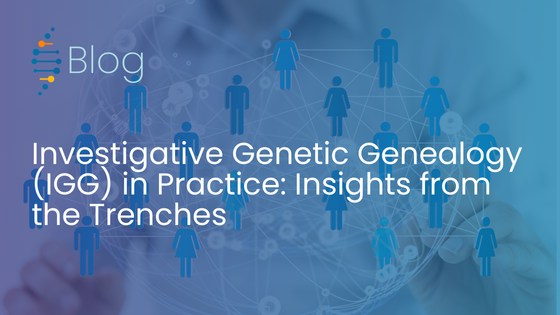This article was generated with the assistance of artificial intelligence. However, all content has been thoroughly reviewed and curated by a human editor before posting to guarantee accuracy, relevance, and quality.
Investigative genetic genealogy (IGG) has become one of the most groundbreaking tools in modern forensic science, helping to solve cases that had gone cold for decades. Most notably, IGG was used in the high-profile capture of the Golden State Killer in 2018, putting this emerging technique in the global spotlight. Since then, IGG has played a critical role in identifying both criminal perpetrators and unidentified human remains (UHR), with hundreds of cases cleared across the United States alone.
However, while its use has grown rapidly, IGG has sparked ongoing debates surrounding privacy, consent, and the proper role it should play in law enforcement. In a 2024 study published in Forensic Science International, Christi J. Guerrini and her colleagues explore the practice, politics, and future of IGG through in-depth interviews with 24 practitioners working directly in the field. Their findings provide a window into the current landscape of IGG, highlighting its value as an investigative tool, as well as the challenges and controversies that continue to shape its evolution.

The Power of IGG as a Lead-Generation Tool
IGG is increasingly being described by practitioners as a transformative tool for generating investigative leads, especially in cases where traditional methods have failed. According to Guerrini’s study, law enforcement professionals working with IGG view it as “the most powerful tool” they’ve encountered in decades. IGG relies on a combination of genetic data from consumer genealogy databases and traditional genealogical research to build family trees that point to possible suspects or identify unknown decedents.
However, interviewees were quick to emphasize that IGG is not itself evidence—it is a means of generating tips. The final confirmation of a suspect’s identity still depends on traditional forensic methods, such as a direct short tandem repeat (STR) comparison between crime scene DNA and a fresh DNA sample collected from the suspect. One law enforcement officer explained that IGG simply provides “an arrow” pointing in the right direction, but it is not the sole reason a case is solved.
This distinction is important for maintaining the integrity of the legal process. Since IGG leads are not themselves admissible as evidence in court, they do not need to be detailed in affidavits or court proceedings. Instead, practitioners are focused on ensuring that IGG is used responsibly as part of a broader investigative toolkit.
The Growth of IGG Expertise and Commercialization
The rapid rise of IGG has led to the expansion of a largely self-regulating industry that provides the services needed to support its use in law enforcement. Genetic genealogists, bioinformaticians, and specialized laboratories now work together to develop single-nucleotide polymorphism (SNP) profiles from DNA samples, search consumer genetic genealogy databases, and assist with constructing family trees to generate investigative leads.
Guerrini’s study found that while demand for these services has driven technical innovation, it has also led to concerns about the uneven quality of service providers. Some genetic genealogists have rushed into the field without the necessary experience or qualifications, leading one interviewee to describe the industry as “the Wild, Wild West”. This lack of regulation has raised questions about whether mandatory licensure for genetic genealogists might be necessary to ensure that law enforcement agencies are working with competent professionals.
At the same time, interviewees noted that law enforcement agencies are beginning to develop in-house IGG capabilities. Many detectives and analysts already have the research skills needed to build family trees, making it feasible for some departments to take IGG into their own hands, rather than outsourcing to independent genealogists. However, the financial and technical barriers to acquiring the necessary equipment and training remain a challenge.
Applications of IGG: Different Cases, Different Challenges
One of the most insightful findings from Guerrini’s research is that IGG applications fall into three broad categories, each with its own set of objectives, practical challenges, and ethical considerations: perpetrator cases, Doe cases, and Baby Doe cases.
Perpetrator Cases
Perpetrator cases, in which IGG is used to identify individuals responsible for violent crimes, are the most common and widely accepted use of the technique. Interviewees explained that IGG has been instrumental in solving cold cases, bringing closure to victims and their families after decades of uncertainty. For law enforcement, IGG’s ability to “remove the word ‘serial’ from serial rapist or serial killer” by identifying perpetrators earlier in an investigation is a major advantage.
Despite its success in cold cases, there is growing support for using IGG in active investigations as well. Interviewees argued that IGG could save investigative resources and prevent further crimes by identifying offenders more quickly. However, there was a strong consensus that IGG should remain limited to violent crimes due to concerns about privacy and public support. As one interviewee put it, “the public is very pro doing this as long as it’s for a violent crime”.
Jane/John Doe Cases
The identification of unknown human remains (Doe cases) is another area where IGG has proven to be invaluable. According to Guerrini’s study, these cases are often seen as the least controversial application of IGG, with public support largely driven by the desire to provide closure to families who have lost loved ones. GEDmatch, one of the primary consumer databases used for IGG, changed its terms of service in 2021 to automatically opt in all participants for Doe cases, reflecting this strong public backing.
Interviewees emphasized the human dignity of identifying deceased individuals, particularly in non-criminal cases, such as deaths from accidents or exposure. They likened IGG in these cases to helping adoptees find their biological parents—both involve bringing closure to families.
Baby Doe Cases
In contrast, Baby Doe cases—where IGG is used to identify deceased newborns or infants—are highly controversial. Interviewees expressed concerns that these cases could lead to the prosecution of women who were in desperate situations, such as poverty or abuse, when they gave birth. Some genetic genealogists reported being “scolded” or “attacked” in online forums for their involvement in these cases, and many declined to work on them altogether out of fear of public backlash.
While some interviewees supported treating Baby Doe cases like any other Doe case, others felt that the moral and legal complexities warranted special consideration. The debate over whether IGG should be used in Baby Doe cases is ongoing, and interviewees stressed the need for more nuanced discussions around these sensitive cases.
Navigating Controversies and Shaping Best Practices
As IGG continues to evolve, the technique faces ongoing controversies, particularly around issues of privacy and consent. One of the most contentious practices involves law enforcement uploading DNA profiles to databases like MyHeritage, which prohibit law enforcement participation, or using other databases in ways that violate their terms of service. Some interviewees strongly opposed this practice, arguing that it could damage public trust and lead to negative media coverage, while others defended it as a necessary part of fulfilling law enforcement’s duty to solve crimes.
Despite these controversies, best practices for IGG are beginning to emerge. There is broad agreement that IGG should be restricted to lead generation, with confirmatory genetic testing required before any arrests are made. Additionally, law enforcement agencies are increasingly following the guidelines set out in the U.S. Department of Justice Interim Policy, which emphasizes the importance of using IGG responsibly and transparently.
However, interviewees repeatedly highlighted the role of public opinion in shaping the future of IGG. Public support for IGG is crucial, as many participants in consumer genetic databases opt in to law enforcement matching voluntarily. Any missteps—such as violating database terms of service—could lead to a backlash, with participants opting out or legislators enacting stricter regulations. As one law enforcement officer put it, “we live and die by public opinion”.
Conclusion
Investigative genetic genealogy has transformed the landscape of forensic science, offering a powerful new tool for solving cold cases, identifying unknown human remains, and bringing closure to families. However, as Guerrini’s study shows, IGG is not without its challenges. The field is still grappling with questions of privacy, consent, and the appropriate boundaries of its use, particularly in controversial cases like Baby Doe investigations.
As IGG continues to grow, practitioners must navigate these controversies while adhering to best practices that ensure public trust and protect the technique’s future. By remaining transparent and responsive to public opinion, forensic scientists, law enforcement, and genetic genealogists can continue to harness the full potential of IGG, while minimizing its risks.
Citations
Guerrini, C.J., Brooks, W.B., Robinson, J.O., Fullerton, S.M., Zoorob, E., & McGuire, A.L. (2024). IGG in the trenches: Results of an in-depth interview study on the practice, politics, and future of investigative genetic genealogy. Forensic Science International, 356, 111946. https://doi.org/10.1016/j.forsciint.2024.111946

